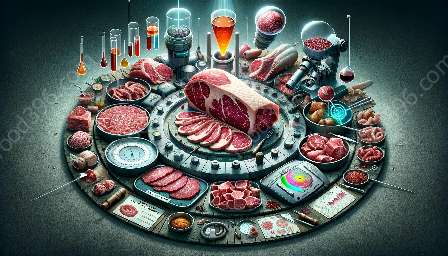Meat sensory analysis offers a captivating journey into the realm of meat science, shedding light on the intricacies of evaluating the sensory attributes of meat products. This article will delve into the significance of sensory analysis in the meat industry, its implications on meat science, and its role in shaping the food and drink landscape. Through this exploration, we will uncover the varied methods and techniques used to assess the sensory characteristics of meat, providing a comprehensive understanding of the impact of sensory analysis on the meat industry and the broader world of food and drink.
The Significance of Sensory Analysis in Meat Science
Sensory analysis plays a pivotal role in meat science, serving as a fundamental tool for evaluating the quality, flavor, texture, and overall consumer acceptance of meat products. By leveraging sensory analysis, meat scientists can gain valuable insights into the sensory attributes of meat, facilitating the development of improved products that cater to consumer preferences and expectations.
The Influence of Sensory Attributes on Consumer Perception
The sensory attributes of meat, including appearance, aroma, flavor, texture, and juiciness, significantly influence consumer perception and purchasing behavior. Understanding and quantifying these sensory attributes through rigorous analysis enables meat producers and researchers to enhance product quality, optimize production processes, and develop meat products that align with consumer preferences.
Methods and Techniques of Meat Sensory Analysis
Meat sensory analysis encompasses a diverse range of methods and techniques designed to evaluate the sensory characteristics of meat products. These may include descriptive sensory analysis, consumer sensory testing, instrumental analysis, and preference mapping, each offering unique insights into the sensory profile and consumer preferences for meat products.
Descriptive Sensory Analysis
Descriptive sensory analysis involves trained panelists who meticulously evaluate and quantify the sensory attributes of meat products, such as flavor, tenderness, juiciness, and aroma, using standardized sensory evaluation techniques. This method provides detailed sensory profiles and facilitates the identification of key sensory characteristics that influence consumer preferences.
Consumer Sensory Testing
Consumer sensory testing involves gathering feedback and preferences directly from consumers through various sensory evaluation methods, such as taste tests, consumer surveys, and focus groups. This approach offers valuable insights into consumer perception, preferences, and acceptance of meat products, informing product development and marketing strategies.
Instrumental Analysis
Instrumental analysis utilizes specialized equipment to measure objective attributes of meat, including texture, color, and juiciness, providing quantitative data that complements sensory evaluations. This method contributes to a comprehensive understanding of meat quality and can aid in the standardization of sensory analysis procedures.
Preference Mapping
Preference mapping involves statistical analysis and graphical representation of sensory data to identify relationships between sensory attributes and consumer preferences. By visualizing the complex interplay of sensory characteristics, preference mapping enables researchers to discern patterns and preferences that drive consumer choices in the meat market.
Applications of Sensory Analysis in the Meat Industry
The insights garnered from sensory analysis have far-reaching implications for the meat industry, influencing product development, process optimization, and quality assurance. Through sensory analysis, meat producers can refine their products to meet consumer expectations, differentiate their offerings in the market, and drive innovation in a highly competitive industry.
Quality Control and Assurance
Sensory analysis serves as a vital component of quality control and assurance in the meat industry, enabling producers to monitor and maintain consistent product quality. By conducting sensory evaluations at various production stages, producers can identify deviations in sensory attributes and take corrective actions to uphold product consistency and sensory appeal.
Product Development and Innovation
Sensory analysis guides product development and innovation by providing actionable insights into consumer preferences and emerging sensory trends. Armed with a deep understanding of sensory attributes and consumer acceptance, meat producers can introduce new flavors, textures, and formats that resonate with evolving consumer demands, fostering innovation in the meat market.
Marketing and Consumer Engagement
Sensory analysis findings contribute to effective marketing strategies and consumer engagement by aligning product attributes with consumer preferences. By leveraging sensory insights, meat producers can craft compelling marketing narratives, communicate product attributes effectively, and build stronger connections with consumers based on sensory appeal.
Meat Sensory Analysis in the Context of Food & Drink
Beyond its impact on meat science and the meat industry, sensory analysis of meat products intersects with the broader domain of food and drink, shaping consumer experiences and industry trends. The sensory attributes of meat play a crucial role in culinary creations, gastronomic experiences, and the overall enjoyment of food and drink.
Culinary Excellence and Gastronomy
Meat sensory analysis informs culinary professionals and chefs in crafting exceptional gastronomic experiences by understanding the nuances of meat flavors, textures, and aromas. By honing their sensory evaluation skills, culinary experts can elevate the sensory appeal of meat-based dishes, creating memorable dining experiences that delight the palate.
Consumer Preferences and Trends
Insights derived from meat sensory analysis contribute to understanding consumer preferences and evolving trends in the food and drink industry. By discerning the sensory nuances that resonate with consumers, food and drink establishments can tailor their offerings to align with sensory preferences, effectively capturing the hearts and palates of discerning consumers.
Collaborative Innovations and Cross-Category Applications
The sensory revelations from meat analysis foster collaborative innovations across food and drink categories, inspiring cross-category applications that leverage the sensory richness of meat. From flavor pairings in beverages to texture enhancements in culinary creations, the sensory attributes of meat permeate various sectors of the food and drink industry, stimulating creativity and diversity in product offerings.
Embracing Sensory Analysis for a Thriving Meat Industry and Delicious Food & Drink Experiences
The profound impact of sensory analysis reverberates through the realms of meat science, food & drink, and consumer experiences, illuminating the intricacies of sensory attributes and their influence on product quality, consumer preferences, and industry innovation. By embracing the multifaceted dimensions of sensory analysis, the meat industry can continually evolve, excite the palate, and deliver enchanting food and drink experiences that captivate consumers worldwide.



















